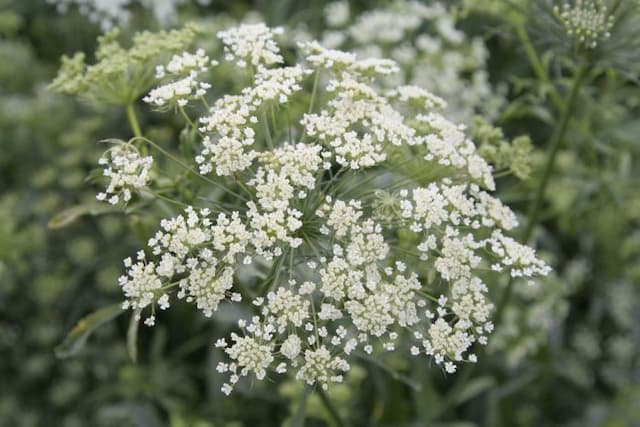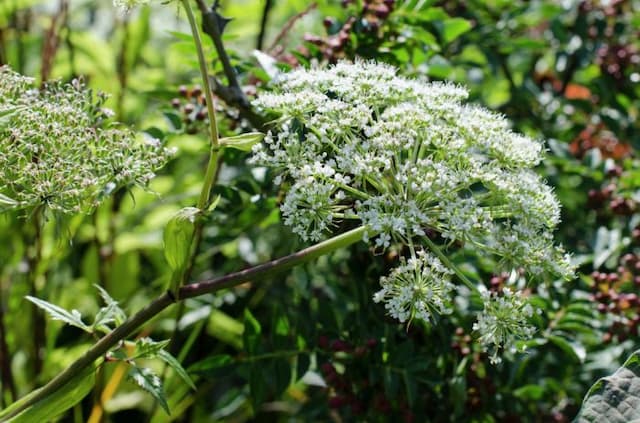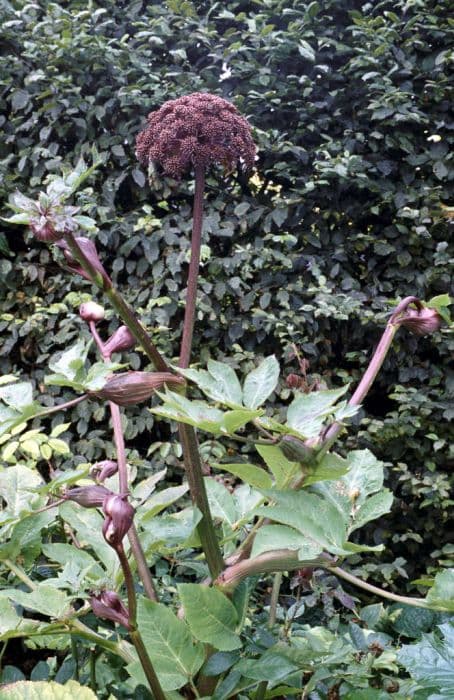Italian Parsley Petroselinum crispum var. neapolitanum

ABOUT
The plant commonly known as flat-leaf parsley or Italian parsley is characterized by its bright green, flat, and non-curly leaves. Unlike its curly-leafed cousin, the leaves on this variety are smooth with a more robust and pronounced flavor. The leaves are broader than those of the curly variety and are arranged neatly in clusters. The stems are also green and slightly grooved, and can often be found carrying several leaf clusters. The plant's overall appearance is lush and vibrant, making it a popular choice both for culinary use and garnishing. Its leaves, when chopped, release a fresh and slightly peppery aroma, which is a hallmark of this popular kitchen herb.
About this plant
 Names
NamesFamily
Apiaceae
Synonyms
Italian Parsley, Flat-Leaf Parsley, Plain-Leaf Parsley
Common names
Petroselinum sativum, Apium petroselinum, Carum petroselinum, Cnidium petroselinum, Petroselinum hortense, Petroselinum vulgare, Selinum petroselinum.
 Toxicity
ToxicityTo humans
Flat-leaf parsley is not toxic to humans and is commonly used as a herb in cooking. However, excessive consumption can potentially lead to adverse reactions because it contains a compound called myristicin, which in very large quantities might be toxic or have psychoactive effects. General symptoms of such myristicin-related toxicity, although rare, can include headache, loss of appetite, and giddiness.
To pets
Flat-leaf parsley in small amounts can be safe for pets, however, in large quantities, it might lead to digestive upset or photosensitization in animals sensitive to this condition. Being rich in oxalates, large consumptions could potentially contribute to kidney problems in pets predisposed to these issues. Symptoms of toxicity might include changes in urination, lethargy, and digestive discomfort.
 Characteristics
CharacteristicsLife cycle
Biennials
Foliage type
Evergreen
Color of leaves
Green
Flower color
Yellow
Height
1 foot (0.3 meters)
Spread
1 foot (0.3 meters)
Plant type
Herb
Hardiness zones
5
Native area
Mediterranean
Benefits
 General Benefits
General Benefits- Culinary Uses: The plant, commonly known as flat-leaf parsley, is widely used as a herb in a variety of cuisines for its fresh, slightly peppery flavor.
- Nutrient-Rich: It is a good source of vitamins A, C, and K, and contains several beneficial nutrients and antioxidants.
- Garden Aesthetic: Flat-leaf parsley can add a lush, green aesthetic to herb gardens or as a border in vegetable gardens.
- Companion Planting: It is beneficial for companion planting as it can help repel certain harmful pests naturally.
- Soil Improvement: When used as a part of crop rotation, parsley can contribute to soil health by breaking up the soil with its roots.
- Cultural Significance: The plant has cultural importance in various traditions, often used in festive decorations and culinary traditions.
- Wildlife Attraction: Flat-leaf parsley flowers can attract beneficial insects such as butterflies, including the Black Swallowtail caterpillar.
 Medical Properties
Medical Properties- Diuretic: The plant is traditionally used to support kidney function and increase urination.
- Carminative: It may relieve flatulence and help in the management of gastrointestinal discomfort.
- Antispasmodic: It may help in reducing muscle spasms, particularly in the digestive system.
- Emmenagogue: It could be used historically to stimulate menstrual flow.
- Rheumatic relief: Folk use includes easing joint pain and rheumatic conditions.
- Vitamin C source: Rich in Vitamin C, providing nutritional support for immune function.
- Iron source: High in iron, which is essential for the formation of red blood cells and preventing anemia.
 Air-purifying Qualities
Air-purifying QualitiesThis plant is not specifically known for air purifying qualities.
 Other Uses
Other Uses- Parsley can be used as a natural dye for fabrics and hair, providing a greenish tint when used in a strong infusion.
- It can serve as an ingredient in homemade skin toners for its refreshing properties when applied topically.
- Used as a natural breath freshener, parsley can temporarily neutralize strong odors like garlic or onion when chewed.
- Parsley stems can be used to flavor stocks and broths, lending a subtle, herbaceous note to the liquid.
- It can be integrated into pest control strategies in gardens, as it can attract beneficial insects that prey on common pests.
- The plant is sometimes incorporated into small bouquets, such as boutonnieres or nosegays, for its vibrant greenery and fresh scent.
- Dried and crushed parsley flakes can be added to homemade soaps for exfoliation and natural color.
- Parsley can be used in artistic presentations, such as vegetable carving and garnishing competitions, for its intricate leafy structure.
- Dried parsley can be utilized in potpourri mixtures, contributing its pleasant aroma and greenery to the blend.
- In culinary schools, parsley is used as a teaching tool for practicing fine chopping techniques like the "chiffonade."
Interesting Facts
 Feng Shui
Feng ShuiThe plant Italian parsley is not used in Feng Shui practice.
 Zodiac Sign Compitability
Zodiac Sign CompitabilityThe plant Italian parsley is not used in astrology practice.
 Plant Symbolism
Plant Symbolism- Ceremonial Uses: In ancient times, Petroselinum crispum var. neapolitanum, commonly known as flat-leaf parsley, was used in ceremonies and could symbolize death as well as protection from evil spirits.
- Victory and Festivity: The Greeks often crowned winners of sports events with parsley wreaths, using it as a symbol of triumph and festivity.
- Health and Strength: The high nutrient content of flat-leaf parsley lends to its symbolism of health, vitality, and strength.
- New Beginnings: Its use in culinary contexts as a garnish can signify a fresh start or the beginning of a meal, suggesting a symbolic representation of newness or beginnings.
 Water
WaterItalian parsley, or Petroselinum crispum var. neapolitanum, prefers consistent moisture, so it should be watered when the top inch of soil feels dry. This usually means watering once or twice a week, but more frequent watering may be necessary during hot, dry periods. Aim to give the plant about 1 gallon of water per week, ensuring that the water penetrates deeply into the soil to encourage root growth. It's best not to water lightly and frequently as this can encourage shallow root systems and make plants less drought-resistant. During the winter months, reduce watering as the plant's growth slows down and it requires less moisture.
 Light
LightItalian parsley thrives in full sun to partial shade, so place it in a spot where it receives at least six hours of sunlight per day. However, in very hot climates, it will benefit from some afternoon shade to protect it from the intense heat of the day. Ideal lighting ensures bright but indirect light, as too much direct sunlight in hotter temperatures can cause the leaves to yellow.
 Temperature
TemperatureItalian parsley grows best in temperatures between 50°F and 70°F but can survive in temperatures as low as 10°F and as high as 90°F. However, prolonged exposure to temperatures outside of its comfortable range can stress the plant. Ideal conditions for growth are cooler temperatures, which help maintain lush, green foliage and prevent the plant from bolting, or going to seed too quickly.
 Pruning
PruningPruning Italian parsley is important for maintaining healthy growth and preventing it from becoming leggy. Trim the plant back by removing the outer leaves regularly to promote new growth from the center. The best time for extensive pruning is in the spring and fall to rejuvenate the plant and encourage bushier growth. Renewal pruning, where a significant portion of the plant is removed, can be done every couple of years if necessary.
 Cleaning
CleaningAs needed
 Soil
SoilItalian parsley prefers a well-draining soil mix rich in organic matter. A blend of two parts garden soil, one part compost or well-rotted manure, and one part sand or perlite would be ideal. Ensure the soil pH is between 5.5 and 6.7 for optimal growth.
 Repotting
RepottingItalian parsley typically does not require frequent repotting and can thrive in the same pot for several seasons. It is an annual or biennial plant, so repotting may only be necessary if the plant survives after the first year or if it becomes root-bound.
 Humidity & Misting
Humidity & MistingItalian parsley grows best in moderate humidity levels. It does not require any special humidity conditions and can adapt to the natural humidity found in most homes and gardens.
 Suitable locations
Suitable locationsIndoor
Place Italian parsley in bright, indirect light indoors.
Outdoor
Plant Italian parsley in full sun to partial shade.
Hardiness zone
5-9 USDA.
 Life cycle
Life cycleItalian flat-leaf parsley, or Petroselinum crispum var. neapolitanum, begins its life cycle with seed germination, which requires light and typically occurs within 1 to 3 weeks at optimal temperatures between 15-20°C (59-68°F). Following germination, the seedlings develop into a rosette of tri-lobed leaves that grow on thin stems, a stage that's crucial for leaf production, the part of the plant most commonly harvested. After the vegetative phase, which can last for several months, the plant undergoes vernalization triggered by cooler temperatures that stimulate the transition to the reproductive stage. During the flowering phase, usually in its second year, the plant produces umbels of small, inconspicuous yellow-green flowers, followed by the development of fruit, which are small, ribbed seeds. If allowed to complete its life cycle, the plant will eventually set seed and then die, being a biennial plant. Throughout its lifecycle, Italian flat-leaf parsley can be harvested for its leaves, which are used as a culinary herb, and if the flowers and seeds are left to mature, they can be collected for propagation or left to self-seed in the garden.
 Propogation
PropogationPropogation time
Spring to early summer
The most popular method of propagating Italian parsley, which is the common name for Petroselinum crispum var. neapolitanum, is by sowing seeds. The best time to sow parsley seeds is during the spring or early summer, after the threat of frost has passed. To propagate Italian parsley by seeds, scatter the seeds onto a well-draining soil mix and lightly cover them with a thin layer of soil, about 1/8 inch (about 3 millimeters) deep. Keep the soil moist but not soggy until germination, which can take between two to five weeks. Thinning out the seedlings is important once they've grown large enough to handle; space them approximately 6 inches (15 centimeters) apart to allow for proper growth and airflow between plants.









